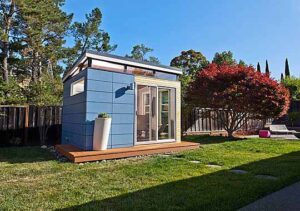In the ever-evolving landscape of remote work, finding the ideal workspace at home can be a challenging endeavor. But what if we told you that you could transform your garden shed into a functional and comfortable office space?

In this SEO-optimized blog post, we’ll explore the possibility of using a shed as an office, the purpose it can serve, step-by-step instructions on how to build a shed office, and considerations regarding shed office size.
Can I Use a Shed as an Office?
The short answer is yes, you can absolutely use a shed as an office. A well-converted shed can offer the perfect balance between a professional workspace and the convenience of working from home. Here are a few reasons why:
- Cost-Effective Solution: Building a shed office is often more budget-friendly than constructing a traditional home office or renting commercial space.
- Separate Workspace: It provides separation from household distractions, allowing you to focus on your work more effectively.
- Customization: You have the freedom to design your shed office to suit your specific needs and preferences.
What Is the Purpose of a Shed?
Sheds traditionally serve as storage spaces for gardening tools, equipment, and outdoor items. However, with a little creativity and planning, they can also be transformed into versatile spaces that serve various purposes, including:
- Workspace: As mentioned earlier, sheds can be turned into home offices, art studios, or workshops.
- Relaxation Retreat: A shed can be a peaceful retreat for reading, meditation, or simply unwinding away from the hustle and bustle of the main house.
- Hobby Space: It’s an excellent place to indulge in hobbies like crafting, woodworking, or gardening without disturbing the household.
How to Build a Shed Office
Creating a shed office involves several key steps:
- Planning: Start by determining the shed’s purpose and sketching out your ideal layout. Consider insulation, electrical wiring, and lighting.
- Insulation: Proper insulation is crucial to ensure comfort year-round. Install insulation in the walls, floor, and roof to regulate temperature.
- Electricity: Hire a professional electrician to wire your shed for power, outlets, and lighting. Ensure you have enough electrical capacity for your office equipment.
- Interior Design: Choose ergonomic furniture, storage solutions, and decor that inspire productivity and make the space comfortable.
- Internet Connection: Ensure a stable internet connection by extending your home network or setting up a separate Wi-Fi router in the shed.
- Heating and Cooling: Depending on your climate, consider adding heating or cooling solutions, such as a space heater or air conditioner.
- Security: Install proper locks and security measures to protect your equipment and belongings.
How Big Is a Shed Office?
The size of your shed office depends on your needs and available space. Typically, a shed office ranges from 100 to 300 square feet. Here are some factors to consider when determining the size:
- Workspace Requirements: Calculate the space needed for your desk, chair, storage, and any other office equipment.
- Comfort: Ensure there’s enough space for you to move around comfortably and accommodate visitors if necessary.
- Storage: Consider storage needs for office supplies, files, and personal belongings.
- Budget: Larger sheds may cost more to convert, so balance your needs with your budget.

Conclusion
In conclusion, using a shed as an office is a practical and cost-effective solution for remote work. With proper planning, insulation, and design, you can create a comfortable and productive workspace right in your backyard. Determine your shed’s purpose, follow the steps to build your shed office, and choose a size that suits your requirements. Transform your shed into a haven of productivity and creativity for a more enjoyable work-from-home experience.
Learn more at Wiki as well.